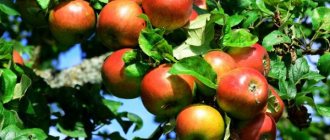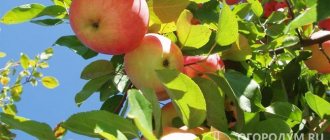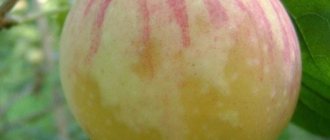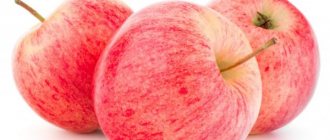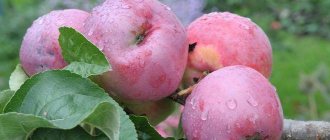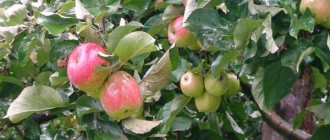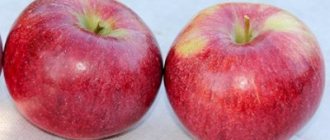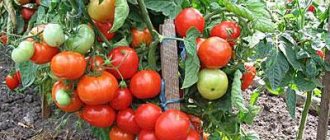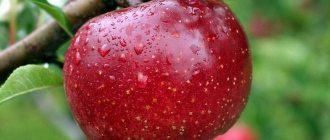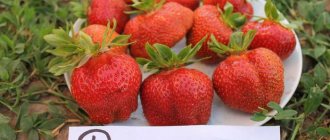It is believed that columnar apple trees appeared in the mid-twentieth century. According to one version, a Canadian scientist accidentally created a tree that bears fruit on one central shoot. The benefits were noticeable immediately: it is much more convenient to collect fruits from such a fruit tree, and in taste and characteristics they are in no way inferior to ordinary ones. The columnar apple tree Malyukha is just such a variety.
Malyukha apple variety.
History of selection
In 1964, in Canada, in the village of Kelowna, on a 50-year-old apple tree of the McIntosh variety, a powerful branch was discovered that had no side conductors, all covered with fruits. Taking advantage of the result of a natural mutation, Canadian breeders propagated the branch and named the new variety Vazhak. The variety had low yields, so it was mainly used for breeding new improved crops, which included Malyukha.
Did you know? Glass balls for decorating a New Year tree are an imitation of real apple fruits. They had to be made due to the poor apple harvest, because before that the tree was decorated with live fruits.
Malyukha was bred in Russia when, in 1976, Vazhak pollen and specimens of columnar apple trees from Great Britain were delivered from Canada. The author of the variety was V.V. Kichina. The variety is named for its small stem height. In Russia, the variety is zoned in the central zone and the Urals, but is grown everywhere. It is also widespread in Ukraine, Belarus, and Poland, due to the high adaptive ability of Malyukha and its decorative appearance.
Features of agricultural technology
Planting the Malyukha variety is no different from a similar procedure performed with other varieties of columnar apple trees. Since planting a crop is not particularly difficult, even a novice gardener can easily cope with the task.
This is done approximately as follows. The purchased planting material is placed in a pre-dug hole with dimensions of 50x50 cm, tied to a peg and covered with earth mixed with fertilizer. Plants should be planted very carefully, trying not to harm the roots in any way.
After planting the Malyukha variety in open ground is completed, it will be necessary to provide the crop with proper care. Only in this case can you count on getting a good harvest
Particularly precise adherence to agrotechnical measures is important in the first years of a plant’s life.
Watering
Malyukha requires moderate watering. If the variety grows on fairly light soil, it will need to be moistened approximately once every two weeks. But here it is necessary to take into account other factors: the climatic features of the planting region and the weather conditions of a particular season. So, for example, if the summer is too hot, the number of waterings increases proportionately. The soil should be slightly moist to a depth of 5 centimeters.
Note! The soil in which the seedling is placed should be constantly checked for moisture content. By doing this, the gardener will be able to create, based on his own experience, an individual watering schedule that will fully meet the needs of the apple tree.
Top dressing
In the first year of growth of the Malyukha apple tree, the plant must be fed with nitroammophoska at the rate of 50 grams of the composition per plant. A month after the procedure, the young apple tree should be fertilized in the same way again. Alternatively, you can use a solution of urea in a proportion of 2 tablespoons of the drug per 10 liters of settled water. The third feeding is carried out another month. You can also use nitroammophoska or urea solution.
Important! Each plant fertilization should be completed with abundant watering and mulching of the soil. The indicated manipulations will allow beneficial substances to be better preserved in the soil.
Disease and pest control
Despite the fact that the Malyukha columnar apple tree has a fairly high resistance to diseases and pests, preventive measures must be carried out annually. Usually, for this purpose, the crop is treated in spring and autumn using any relatively safe insecticides and fungicides. The most important thing is to do this before the buds swell in the spring and after harvesting in the fall.
Spraying an apple tree against pests
Description of the variety
Malyukha has attractive external characteristics - the trees are cultivated not only as fruit trees, but also as ornamental crops. They create interesting garden compositions in combination with flowers or other columnar fruit crops.
External features
The tree is compact. The height of an adult specimen reaches 180 cm, less often 200 cm. The crown is pyramidal or columnar, depending on whether shaping is performed or not. The trunk is much thicker than that of ordinary trees. It is covered with small growing branches, at the ends of which flower buds form. The side shoots never become as powerful as those of conventional varieties.
From 3-4 years of growth on the site, the growth force of lateral shoots decreases. The plant develops vertically, without lateral branching, only if the central point is not cut off. The foliage of the plant is average. The leaf blades are oval in shape, with a pointed end. The outer side of the leaf has a bright green color, the inner side is a lighter tone, matte, with pubescence.
Find out what an apple is and what its features are.
Properties of apples
Apples have a rounded-flattened shape. Their weight is 250 g. The peel is thin and resistant to mechanical damage. It is colored yellow-green with a slight red blush. The pulp is light, very juicy. Has a dense structure. The taste is sweet and sour. In terms of use, the fruits are universal. They are perfect for various types of processing and fresh consumption, and can also be the subject of commercial activity.
If not properly cared for, the tree will produce not only small fruits, but also minimal yield. Or it may even refuse to bear fruit.
Advantages and disadvantages
Like most other fruit crops, the Malyukha variety has both certain advantages and disadvantages. The advantages of the variety include the following significant points:
- due to the compactness of the tree, caring for it will not be particularly difficult (as well as harvesting);
- trees can be planted quite densely due to the lack of side branches and spreading crown;
- the fruits hold on to the branches very tightly and do not fall off even if you start to shake the tree;
- the apple variety has a beautiful and aesthetic appearance;
- the culture is precocious;
- the variety is best suited for planting in regions with less than favorable climatic conditions;
- with proper storage, apples can be preserved without losing their marketable characteristics until December;
- The baby has a high immunity to scab and most other diseases.
There are not many disadvantages to be found in this variety. As a rule, most gardeners focus their attention on only two points. We are talking about the too high cost of seedlings of a columnar plant and the not too long period of fruiting.
If we talk about the variety as a whole, it should be noted that the number of advantages clearly outweighs the existing disadvantages. Therefore, choosing the Malyukha apple tree for planting in your garden plot will be the right decision, the decision of which you will not have to regret.
Characteristics of wood
Malyukha has very attractive characteristics for gardeners. In addition to external and qualitative data, the variety is characterized by high survival rate on any type of soil.
Did you know? Apples are a natural sugar substitute
due to their high fructose content .
Winter hardiness and immunity to disease
The plant has high winter hardiness - it easily tolerates frosts down to –40°C. As for diseases, the plant is highly resistant to scab and most fungal pathogens. Very rarely affected by pests.
Pollination and timing of apple ripening
The tree is self-fertile, so pollinating varieties should be planted nearby. The most suitable in this regard are Currency, Kitayka, Chervonets. The fruits reach harvest maturity, which coincides with consumer maturity, in September. After harvesting, the fruits are perfectly preserved until January inclusive.
Fruiting of the columnar apple tree Malyukha.
The main differences between the columnar apple tree variety Malyukha and other varieties
The main difference between the variety in question and others is its super-high precocity. The plant is capable of producing a harvest a year after planting. The productivity of an apple tree increases exponentially, and by the 4-5th year of life the plant produces 15 kg of fruit. At the same time, most other varieties are just beginning to produce their first harvest.
The Malyukha variety is famous not only for its taste, but also for its high keeping quality. Another difference is the uniform distribution of the fruit along the trunk, which completely eliminates its damage. Few varieties can boast of high resistance to scab and most fungal diseases. Thanks to this, the gardener will not have to treat the plants with chemicals - it will be enough to carry out preventive treatment with biological products only a few times a year.
We recommend that you familiarize yourself with the autumn varieties of apple trees:
Pollination
In order for an apple tree to show its potential, it needs suitable pollinators. Chervonets, Valya, Kitayka gold and red will cope with this task perfectly. Since columnar varieties take up little space, you can plant a whole collection of varieties, selecting them according to their flowering time. True, not every gardener can afford such variety - the prices for such unusual apple trees are quite high.
Optimal conditions for planting
In order for plants to quickly take root and develop well, they need a well-lit area, protected from the north side from the blowing wind. In areas exposed to drafts and shade, the fruits do not collect enough juice.
The tree does not tolerate close groundwater, so it should not be planted in low areas. Even with high frost resistance, the buds periodically die in winter, which negatively affects the yield. Regarding the soil, the main requirement is good drainage. Plants do not tolerate waterlogging, so you should pay attention to the location of groundwater: the distance to it should be at least 2 m.
The origin of columnar wonderful apple trees
The origins of this new tree species for our region go back to distant Canada. There, on one of the branches of the apple tree, an anomaly occurred, which became a precedent for the creation of a new type of tree.
Thanks to the structure of this branch, breeders recreated it in a new plant, which in its shape resembled a column. The first varieties were still apple trees. Then pears, plums and other fruit trees appeared.
Beginning in the 90s of the last century, the first columnar apple trees appeared on the territory of our country, which was a godsend for the country’s gardeners. Then it cost a lot of money to get them, but “the game was worth the candle.”
Now this apple tree is gaining more and more popularity in Russia and is absolutely accessible to domestic gardeners and gardeners. Now you can even choose the desired size of this miracle tree. They exist in dwarf, semi-dwarf form and are average trees.
Rules for planting the Malyukha variety
The columnar Malyukha apple tree is planted only in spring. Plant in mid-spring, before the buds bloom on the seedling. It is important that during this period the weather is warm enough and the risk of return frosts has passed. The average daily air temperature when planting a plant should be at least +10°C. The soil should warm up to at least a temperature of +3°C.
Important! Green manure plants, for example, phacelia, or grains can be sown between the rows of seedlings. They will attract pollinating insects and improve soil aeration.
Site preparation begins in the fall. The area is leveled and cleared of vegetation. Then they are cultivated to a depth of 30 cm and treated with a disinfectant composition - use a 3% solution of copper sulfate or Fitosporin diluted with water 5:10. A week after this treatment, the following is added to each m²:
- 10 kg of compost and sand (if you need to lighten the soil, not necessary on light soils);
- 20 kg of fresh or rotted manure;
- 500 g superphosphate.
To prevent the apple tree from experiencing hunger and thirst during growth, you need to properly prepare the soil mixture. After applying fertilizers, cultivation is carried out again and the area is left in this state until spring. A month before planting, cultivation is carried out again. Planting holes begin to be prepared before planting. The size of the holes is 50x60 cm. A distance of 1–1.5 m is left between the holes and rows.
Planting process:
- A 25 cm high layer of sand and crushed stone mixed 2:1 is poured into the bottom of the pit.
- Then add 4 kg of humus, 80 g of superphosphate and 40 g of potassium sulfate to the top layer of soil.
- A stake is placed in the center of the pit, and then a small elevation is formed next to it.
- The roots of the seedling are placed on it and straightened. Be sure to level it along the root collar so that after filling the hole it is 5 cm above the ground.
- When all manipulations are completed, fill the hole with soil, alternating clean and fertilized. Periodically, shake the seedling a little to eliminate the risk of voids forming in the hole.
- Next, the soil in the tree trunk circle is compacted and 20 liters of water are poured into the hole.
Video: planting a columnar apple tree
External parameters
The columnar Malyukha apple tree is compact in size, as can be seen from the photo. This is an advantage and a disadvantage at the same time.
Tree growth
The compact Malyukha variety usually reaches a height of about 180 cm, in rare cases - 200 cm. This makes it very convenient for caring for and collecting fruits. In unfavorable conditions, growth stops earlier. But in normal conditions, the apple tree will need to be pinched.
Crown size
The crown is medium compact even by speaker standards. The foliage is also average. Internodes are short, the trunk is strong. The apple tree is a natural dwarf, so it does not grow to the sides.
Tree variety of columnar apple tree Malyukha.
Annual growth
The short apple tree grows quite slowly. An annual growth of 10-15 cm is normal. But it is achieved only under good conditions. Otherwise, the tree will develop more slowly.
Lifespan of a tree
The Malyukha apple tree begins to bear fruit very early, sometimes even in the year of planting. The apple tree produces a harvest of up to 15 years of life, but with age the number of fruits decreases. Usually, from the 7th year to the 12th year, the apple tree produces the largest amount of harvest.
Landing
Proper planting of an apple tree will be the key to its health and full development. That is why it is necessary to select optimal conditions and terms. Care should be taken:
- so that the place is protected from the cold, but in the sun. Groundwater should be located further away, and the soil should be fertile;
- the pre-prepared planting hole was filled with nutrients. If there are warm beds on the site, then seedlings can be planted in them;
- after planting, it is necessary to ensure that the root collar is located at ground level;
- mulch after planting and renew the layer of covering material before the onset of cold weather.
The distance between small trees should be about 1.5 meters. This is necessary so that the roots have enough space and the crown has enough light.
Preparing for planting a columnar apple tree.
